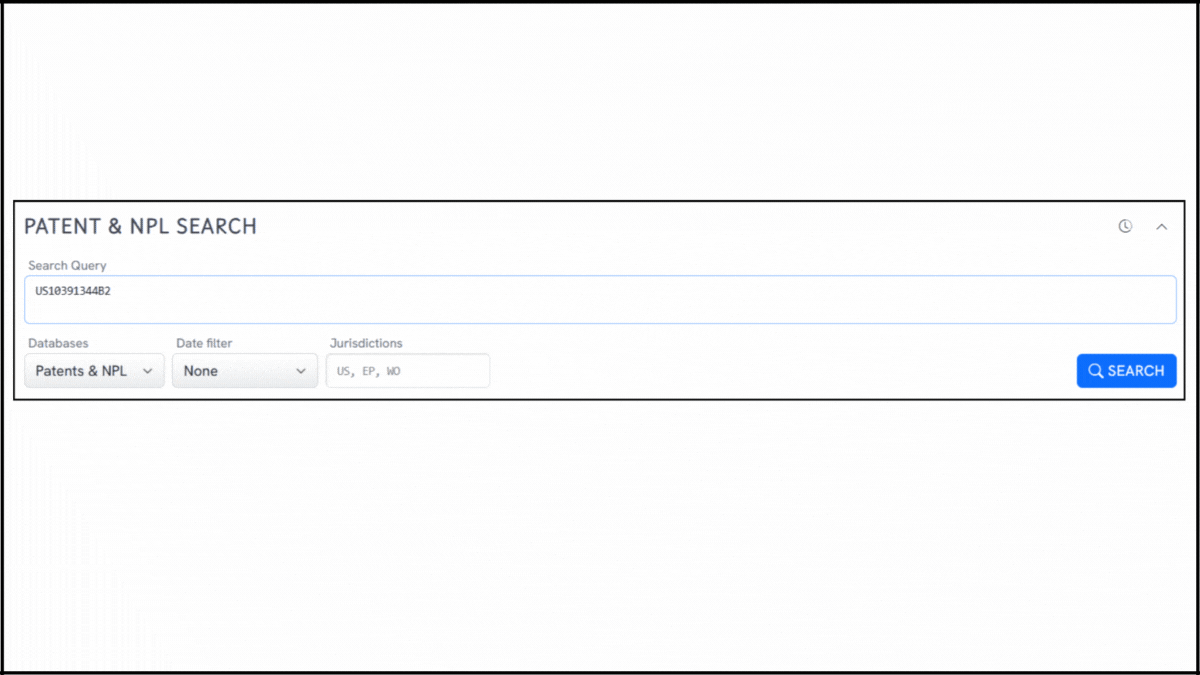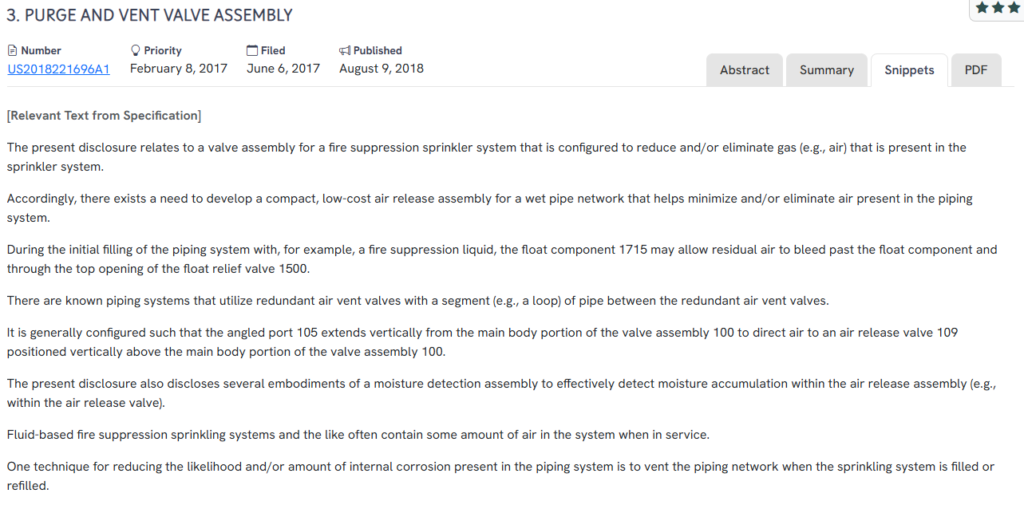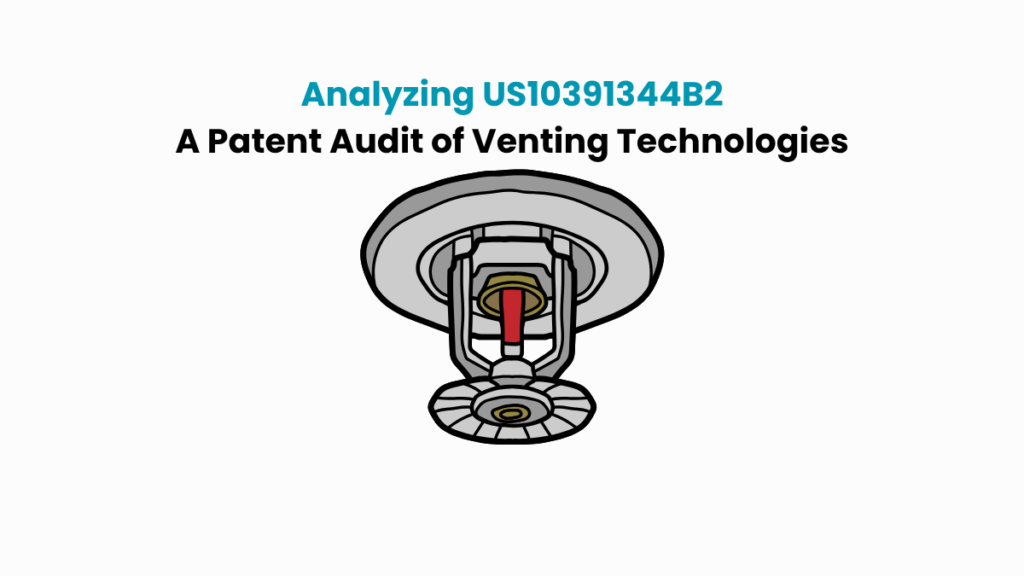Some inventions quietly support everyday systems. Others attract attention because they solve practical problems with precision and industry-wide relevance. US10391344B2 falls into the latter category.
Recently, this patent has been cited in the case of AGF Manufacturing, Inc. v. Core & Main LP et al. Without focusing on legal specifics, it’s worth exploring the invention’s technical foundation. This patent describes a purge and vent valve assembly used in wet-pipe networks, particularly in fire sprinkler systems. It vents trapped air as water fills the system, improving safety, responsiveness, and reliability.
In this article, we use the Global Patent Search (GPS) tool to investigate conceptually similar inventions. Rather than offering legal commentary, we’re focused on comparable designs and technical overlaps. If you work in fluid control systems or IP analysis, this feature-based review of US10391344B2, built on our stress-testing approach, will offer valuable insight.
Understanding Patent US10391344B2
US10391344B2 discloses a purge and vent valve assembly designed for use in wet pipe systems, such as fire suppression sprinkler networks. The invention enables automatic removal of trapped air during system filling and incorporates components to detect and manage moisture accumulation. It improves corrosion prevention and system maintenance by integrating air release, moisture detection, and purge capabilities in a compact and efficient assembly.

Its four key features are
#1. Integrated valve assembly: Combines a cylindrical flow chamber, inlet and outlet valves, a strainer, and an angled port for air release into a unitary structure.
#2. Air release mechanism: Vents air from the piping system via an air release valve connected to the angled port.
#3. Moisture detection assembly: Uses a condensate chamber and detection device (e.g., sensor, float, or pop-up indicator) to monitor moisture buildup.
#4. Float relief valve: Includes a float mechanism that automatically seals when fluid enters, and reopens for residual air release via a manual valve.
This design addresses long-standing challenges in removing air and managing moisture within fire suppression piping systems. It offers a modular, cost-effective solution that enhances system longevity and operational reliability.
Similar Patents As US10391344B2
To explore the innovation landscape surrounding US10391344B2, we ran the patent through the Global Patent Search tool. Below is a quick glimpse of the GPS tool in action:

Source: Global Patent Search
This analysis surfaced a list of related patents that share technical similarities in air venting, corrosion prevention, and compact valve design. Below, we highlight five of these references that reflect comparable approaches in fire suppression system functionality.
These examples offer insight into how similar challenges have been addressed across international systems. For comparison, see how we explored user interaction and thermal control in another recent patent audit of US9462897B2.
#1. CN110475994B
This Chinese patent, CN110475994B, published in 2022, describes an air release kit specifically designed for fire extinguishing sprinkler systems. It centers on minimizing trapped air to prevent internal corrosion and extend system life.

What this patent introduces to the landscape?
- Integrated valve assembly for fire sprinkler systems: Designed to reduce or eliminate air trapped in the piping network.
- Angled port design: Uses a vertically extending angled port that connects to an air release valve for venting residual air.
- Corrosion prevention: Emphasizes the dangers of air-induced corrosion and proposes structural remedies within the valve assembly.
- Compact and low-cost construction: Targets affordability and simplicity without compromising air removal efficiency.
How it connects to US10391344B2?
- Both use angled ports connected to an air release valve for venting trapped air.
- Each aims to eliminate corrosion by reducing internal oxygen exposure.
- The focus on compact, cost-effective design aligns with the goals of US10391344B2.
Why this matters?
This prior work reinforces the importance of managing trapped gas in fire suppression systems. It highlights a shared global engineering concern and underscores the role of angled port-based air release mechanisms in achieving safer, more durable installations.
#2. JP2008188416A
This Japanese patent, JP2008188416A, published in 2008, describes a sprinkler piping member that features an air vent to evacuate trapped air from the system and prevent its reentry.

What this patent introduces to the landscape?
- Integrated air vent system: Incorporates air vent 56A directly into the sprinkler piping member to manage trapped air.
- Air isolation between components: Prevents air from entering the space between the sprinkler head and branch header.
- Water stopcock mechanism: Uses a water stopcock to control the open or closed state of the air vent.
- Focus on system sealing: Aims to maintain a tightly controlled fluid environment within the sprinkler pipe network.
How it connects to US10391344B2?
- Both patents incorporate venting mechanisms to evacuate residual air from fire suppression systems.
- Each solution includes structural components (such as stopcocks or valves) to manage airflow and prevent reentry.
- The shared goal is to preserve system integrity and reduce corrosion risks.
Why this matters?
This patent highlights alternative approaches to air evacuation within sprinkler piping assemblies. It reinforces the principle that controlling air presence at key junctions is critical for maintaining effective fire suppression performance and long-term system health.
#3. US20180221696A1
This U.S. pre-grant publication, US20180221696A1, released in 2018, presents a purge and vent valve assembly designed to evacuate trapped air and monitor moisture within wet pipe fire suppression systems.

What this patent introduces to the landscape?
- Compact air release assembly: Focuses on reducing trapped air during initial system fill using a vertically oriented angled port and air release valve.
- Float-based venting mechanism: Uses a float component to allow air bleed-through during filling, then seals once fluid enters.
- Redundant air vent valve architecture: Discusses looped piping configurations for dual venting.
- Moisture detection system: Integrates assemblies to monitor and manage moisture buildup in the air release valve area.
How it connects to US10391344B2?
- Both share nearly identical configurations, including angled ports, float-operated relief valves, and moisture detection assemblies.
- The goals of venting air and preventing internal corrosion are identical.
- The design structure, including vertical valve orientation, directly mirrors that of US10391344B2.
Why this matters?
As a continuation-in-part of the issued US10391344B2, this filing offers deep insight into the developmental iterations of the purge and vent concept. It reinforces the technical foundation of the later patent and outlines earlier embodiments that shaped its structure and functionality.
#4. JPH0574554U
This Japanese utility model, JPH0574554U, published in 1993, describes a firefighting pipe configuration that includes automatic air venting and controlled water flow to sprinkler heads.

What this patent introduces to the landscape?
- Automatic air vent valve: Designed to release trapped air from the fire extinguishing pipe before water reaches the sprinkler system.
- Dry pipe section design: Prevents water from entering the piping that supports the sprinkler head during non-emergency conditions.
- Controlled air pressure regulation: Manages downstream air pressure through a check valve near the sprinkler head interface.
- Pre-fill air evacuation: Enables air discharge at key locations before water begins to flow through the system.
How it connects to US10391344B2?
- Both systems prioritize air evacuation before water fills the network.
- Each incorporates automatic venting to reduce internal corrosion risks.
- The focus on maintaining dry sprinkler piping until activation aligns with air management principles in US10391344B2.
Why this matters?
This early design reveals longstanding concerns with trapped air in fire suppression systems. The integration of automatic venting mechanisms reflects a foundational approach that parallels modern purge and vent solutions in ensuring optimal system readiness and reliability.
#5. DE19509875A1
This German patent application, DE19509875A1, published in 1996, outlines an apparatus for venting pipe systems with a focus on operational simplicity and improved gas discharge.

What this patent introduces to the landscape?
- Simplified venting device: Emphasizes ease of use and structural simplicity in air removal design.
- Gas discharge from pipe systems: Aims to eliminate air trapped in various fluid transport networks efficiently.
- Inline integration: Suggests embedding the venting mechanism directly within existing piping infrastructure.
- General-purpose application: Although not specifically designed for fire suppression, it offers transferable concepts in air evacuation technology.
How it connects to US10391344B2?
- Both target the problem of trapped gas in pipe systems.
- Each values simplicity and compactness in venting mechanism design.
- The core function of discharging air before full fluid flow aligns closely with US10391344B2.
Why this matters?
While broader in scope, this reference demonstrates how streamlined venting technologies can influence system efficiency. Its commitment to simplicity and inline integration mirrors the goals of US10391344B2 in delivering practical, low-profile air management solutions for fluid-based systems.
How to Find Related Patents Using Global Patent Search?

Understanding the broader patent landscape is key when working on venting systems, moisture control, or corrosion prevention in fire sprinkler networks. The Global Patent Search tool, like many advanced patent analysis tools, streamlines this process, helping users identify systems that reflect similar fluid-handling assemblies or integrated venting mechanisms.
1. Enter the patent number into GPS: Start by entering a patent number like US10391344B2 into the GPS tool. The platform transforms it into a smart query, which you can refine using terms like air release valve, moisture detection, or purge assembly.

2. Explore conceptual snippets: Instead of comparing features claim-by-claim, GPS now offers curated text snippets. These highlight how other systems evacuate air, manage pressure, or prevent moisture accumulation in fluid networks.

3. Identify related inventions: The tool reveals patents that focus on pipe network reliability, prevent corrosion, or use modular venting components, showing how associated problems have been addressed across time.
4. Compare systems, not legal claims: Rather than focusing on formal legal language, GPS compares system behaviors. This helps users trace functional overlaps without having to navigate legal boundaries.
5. Accelerate cross-domain insights: Whether you’re working in fire protection, fluid control, or HVAC design, GPS lets you uncover related ideas across technical domains that may otherwise be hard to connect.
With this approach, Global Patent Search gives engineers, analysts, and IP teams a concept-first way to explore connected technologies and inform better product or patent strategies.
Disclaimer: The information provided in this article is for informational purposes only and should not be considered legal advice. The related patent references mentioned are preliminary results from the Global Patent Search tool and do not guarantee legal significance. For a comprehensive related patent analysis, we recommend conducting a detailed search using GPS or consulting a patent attorney.




